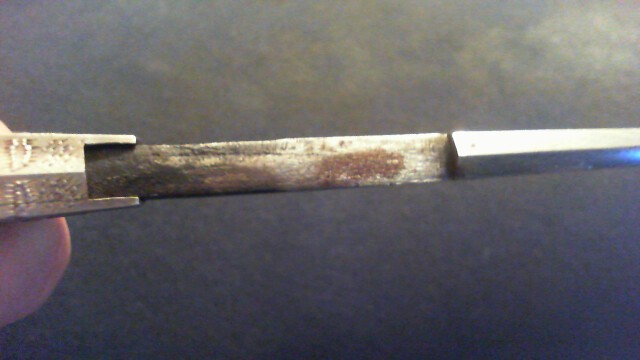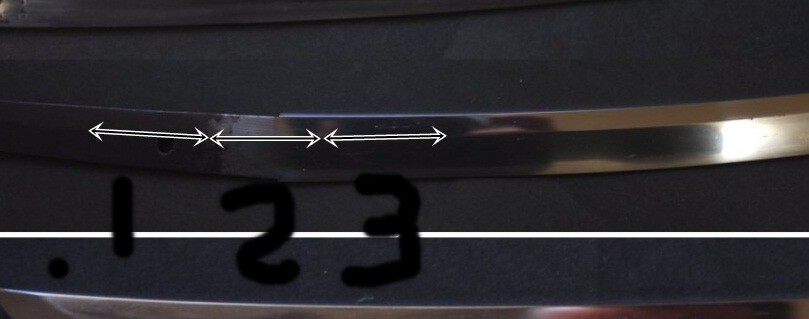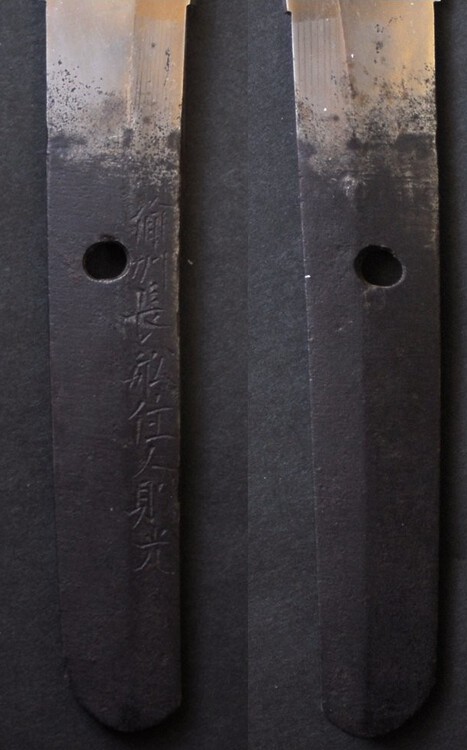
gtstcactus
Members-
Posts
305 -
Joined
-
Last visited
Everything posted by gtstcactus
-
It sure is great news!!!!!!! Chris, I totally see where you (and others who mentioned the possible welded nakago) were coming from based on the photos. They really did look suspicious.... Now that we have established it's not fatally flawed in that department.... Could anyone say if this was once a decent sword screwed up by the last polisher???
-
As I mentioned in the other thread, I've had it looked at by the person whom I was refered to for opinions on my second wakizashi. He says the nakago is not welded and the suggestion is way off, also said "the polisher has not wanted to move the shinogi down to follow the contour of the nakago and this is just poor workmanship rather than a welded nakago" He also thinks the mei is probably not gimei, but a later period work.... He also happens to be coordinating getting pieces from NZ to the shinsa in Sydney and said I could certainly submit this blade in it's current state for shinsa. If he thought it would be a waste of time I think he'd have said don't bother, just like he did about regarding another blade I had him look at. I don't need to sell this to fund a trip to sydney..... There are things other than money which I have to consider, which may mean I can't make it.
-
I managed to get rid of the light.... not sure if it's a worse picture tho.... I'm not very good with cameras and photo editing software. I'm not sure how to do a clickable thumbnail..... The width of the shinogi-ji is...... On both sides just on the tsuka side of the yokote the width is 7mm, in the middle of the blade the width is 7.5mm-8mm (both sides), on the blade side of the machi the width is 8-8.5mm, on the mei side of the polishers marks width is 8.5-9mm. So there is some deviation, but I just checked one of my other blades and it seems to follow a similiar pattern. Also I just got word from the polisher (not the one who polished it) and he says it is definately not a welded nakago, the suggestion is way off.... He also said "the polisher has not wanted to move the shinogi down to follow the contour of the nakago and this is just poor workmanship rather than a welded nakago"
-
-
What about the wakizashi signed Hiromitsu from nambokucho period, at the Nezu Institute of Fine arts tokyo? Or the wakizashi signaed soshu ju akihiro from 1364 at the kimura art museum, kanagwa Or the wakizashi by sadamune known as Fushimi Sadamune kamakura - nambokucho period, at the kurokawa institute of ancient culture or the 2 wakizashi known as tokuzenin sadamune, and monoyoshi sadamune. These are all from the book / catalogue Masamune: A Genius Swordsmith and his legacy. The signed ones are signed with katanamei. Unless I have misunderstood something it seems to me wakizashi were being made in the kamakura - nambokucho period
-
David, I said right from the start I know it's not a real high quality piece..... but it's not as bad as the photos make people think... If and when I sell it I will double if not triple my money, much like the 1st wakizashi I purchased (satsuma rebellion) which was rubbished here as well.
-
Jean, are you saying wakizashi were not made in the Nambokucho period? I thought they were. Have I misunderstood what you were saying?
-
I will see what James Jordan says about it, he's probably one of the most knowledgeable people I'm in contact with in NZ. I'll try and get an in hand evaluation. I still don't think the nakago is welded on, I've had a couple of people who work with metal look at it and both agree it is does not appear welded, admittedly they are not nihonto experts but they are knowledgeable about metal work. Could this have been a decent blade blade done a dis-service by a less than brilliant polisher? (bearing in mind only an in hand examination is going to resolve the welded or not nakago.) Despite this portion of the blade being under question there are plenty of other good bits on the sword for me to study. The hada, hamon, boshi and other bits and bobs I can't think of the correct terms for at the moment, none of which photographed very well.... Thanks for opinions and comments so far.... especially reinhards, that really added to the thread!
-
Thanks Keith, I'll get the book out later tonight and check the relevant section.... Jas
-
If you could see it in hand I think you might think differently...... I respect your input and opinions, and will seek advice /opinion from James Jordan... I too hope it is not the case!!! If it were the case would there be any signs on the sides of the blade?
-
I have checked carefully, I do not think it is a welded nakago. The photo does not show all the right angles. It looks more like a chip out of the mune which may have been filed down.
-
Grey, do you mean the mune when you say the edge? It does look like a chip may have been made in the mune (as shown in the machimune pic in the other thread) and has been filed down, now all that is shown is the "crack / line" that chris mentioned in the other thread but it really looks like a chip now you mention it.
-
No it's not a crack, it's a tad uneven almost like a flake of steel corroded away (I doubt that's the cause but can't think how else to describe it)
-
Suguha hamons - inferior / boring???
gtstcactus replied to gtstcactus's topic in General Nihonto Related Discussion
I guess we've kind of gone off topic here... But you guys (Chris and Paul) have hit the nail on the head in regards to there being no substitute for seeing swords in hands, whilst books are invaluble learning tools somethings can simply not be seen in pictures. Having said that even having a sword in hand may not be incredibly benificial if the holder doesn't really know what they are looking at / for. I guess thats when having someone more knowledgeable around would be helpul (such as at a show). In looking at drawn images of various features in books recommended by members I'm still not sure I know what I'm looking for when you go to looking at an actual blade. Utsuri is something I'm not sure I recognise yet, I know it in images but looking at a blade it's not so clear (perhaps I need better blades to look at). There are others too as I'm still learning and the learning curve is steep. For me I learn best when shown things.... Some learn best from books, others from listening..... -
heres a photo of the mune machi looking down on it.... Not sure if this helps get to the bottom of it or not...
-
Excuse my crude drawing.... The side of the blade not shown in the photo seems fine, however on this side (shown) The shinogi runs parallell to the mune at arrows 1 & 3, where I've got arrow 2 at the machi the shinogi seems to run straight briefly (instead of following the gentle curve) before returning to the gentle curve and parrallel to the mune at arrow 1&3..... Would this be the wandering you refer to??? When looking at the blade as you suggested this is the only thing looking "odd"
-
Sorry about the multiple threads...... I'll blame it on my ADHD.... (and Jean cos he started one!) I would very much like to discover why the polisher or polishers have decreased the width of the shinogi-ji, the shinogi has been moved towards the mune above the nakago, if this is the case...
-
I've just checked and the shinogi of the blade does carry on straight / smoothly to the shinogi of the nakago, the photo does slightly distort it's appearance. The polishers marks follow the line of the mune machi when looked at by the naked eye, theres a deviance of about 1mm when magnified however much the photo is magnified by.
-
David, By any chance is there an image of the Norimitsu mei with ju in it? Do you know if he used the same characters for his name? Is there any / much info on said norimitsu?
-
I would have thought the polishers mark were added later...... With the blade in hand it does not show any signs of having being welded... but I probably don't know what I'm looking for.
-
Jean has told me there is something very wrong with this sword and referred me to pictures norimitsu2 and norimitsu14. something to do with the "lines" or the polishers signature as he put it. I'm waiting for Jean to PM me about it but really want to know whats wrong so I'm asking here as it's relevant to the thread.... So can anyone fill me in? Jean says the lines should run \\ to the shinogi I think, but they instead are more inline with shinogi but tapering off... Surely this can't be too major????!!!
-
Hey Folk, I have this wakizashi (posted about in nihonto forum) which is signed Bishu osafune junin norimitsu. So far it seems the mei does not match any known examples... So is it gimei? I'm no expert so am likely to be shot down for this theory but if one was forging a norimitsu mei wouldn't they sign it the way the orignal was signed and not in a different way? The blade also lacks the date being inscribed which I am told was often done by some norimitsu of osafune school (I think I recall right). It was suggested that it could be an unknown Norimitsu or later generation.... Is there anyway to find out about "relatively unknown" smiths?
-
Shirasaya - Should I stain or oil?
gtstcactus replied to gtstcactus's topic in General Nihonto Related Discussion
Thanks for the replies guys. Jean: I don't think the shirasaya caused the black marking / rust... It (shirasaya) doesn't look that bad as it is so I'll take the advice and refrain from oil and or stain / tan. Over a few years it should develop a nice patina...... -
Hi Folk, The wakizashi I recently received from Japan came in Shirasaya, as with so many swords the police registration / license was taped to the saya for many, many years. So long the glue from the tape had stained / soaked right into the wood. using alcohol wipes would not remove the marks, it even made the shirsaya look like it was made of 4 pieces of wood instead of 1. I ended up lightly sanding the stains off. Should I sand the whole thing and tan / stain it with an appropriate product from the paint store (I'm guessing something like you might stain outdoor furniture with) or perhaps oiling it with something like Linseed oil (like we used to oil our cricket bats with).... Or as one chap suggested just leave it alone now.... It just doesn't look even as I only sanded out the blemishes / stains
-
Thanks for your input guys..... It really does look well ah "wrong" after considering your comments....





